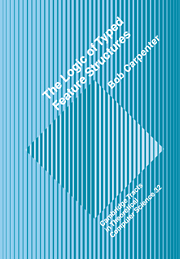 The Logic of Typed Feature Structures
The Logic of Typed Feature Structures 13 - Unification-Based Phrase Structure Grammars
Published online by Cambridge University Press: 12 October 2009
Summary
In this chapter, we consider a phrase structure grammar formalism, or more precisely, a parameterized family of such formalisms, in which non-terminal (category) symbols are replaced by feature structures in both rewriting rules and lexical entries. Consequently, the application of a rewriting rule must be mediated by unification rather than by simple symbol matching. This explains why grammar formalisms such as the one we present here have come to be known as unification-based. Although our presentation of unification-based phrase structure grammars is self contained, for those unfamiliar with unification-based grammars and their applications, we recommend reading Shieber's excellent introduction (Shieber 1986). Shieber lays out the fundamental principles of unification-based phrase structure formalisms along with some of their more familar incarnations, as well as providing a wide variety of linguistic examples and motivations. Another good introductory source is the text by Gazdar and Mellish (1989).
The early development of unification-based grammars was intimately connected with the development of logic programming itself, the most obvious link stemming from Colmerauer's research into Q-systems (1970) and Metamorphosis Grammars (1978). In fact, Colmerauer's development of Prolog was motivated by the desire to provide a powerful yet efficient implementation environment for natural language grammars. The subsequent popularity of Prolog led to the development of a number of so-called logic grammar systems. These grammar formalisms are typically variations of first-order term unification phrase structure grammars such as the Definite Clause Grammars (DCGS) of Pereira and Warren (1980), the Extraposition Grammars of Pereira (1981), the Slot Grammars of McCord (1981) and also the Gapping Grammars of Dahl and Abramson (1984, Popowich 1985).
- Type
- Chapter
- Information
- The Logic of Typed Feature StructuresWith Applications to Unification Grammars, Logic Programs and Constraint Resolution, pp. 185 - 214Publisher: Cambridge University PressPrint publication year: 1992
